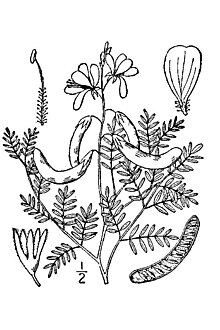Hoffmannseggia glauca
| Pig-nut | |
|---|---|

| |
| Scientific classification | |
| Kingdom: | |
| (unranked): | |
| (unranked): | |
| (unranked): | |
| Order: | |
| Family: | |
| Genus: | |
| Species: | H. glauca
|
| Binomial name | |
| Hoffmannseggia glauca (Ortega) Eifert
| |
Hoffmannseggia glauca is a dicot found in the legume family, Fabaceae. Its common names include Indian rushpea, hog potato, and pig nut.
It is a California native which prefers alkaline desert flats, creosote bush communities, and disturbed areas. It prefers elevations of less than 900 metres (3,000 ft). Hoffmannseggia glauca is found outside California in Western Nevada, Texas, Mexico and South America. In California H. glauca may be found in the San Joaquin Valley, Southern Coastal Ranges, and Western Transverse Ranges.
Description
Hoffmannseggia glauca is an erect perennial herb and can measure up to 30 cm tall. Branches are slender, growing out from the base of the plant, and have stalked glands. The foliage is composed of compound leaves with primary and secondary leaflets. Primary leaflets (5-20 mm) are odd-pinnate while secondary leaflets (4-6 mm) are even-pinnate.
The inflorescence measures 5-15 cm and is glandular. Flowers are orange-red with spreading petals and are produced between the months of April and June. The fruit that develops is 1.5-4 cm, glandular, curved, and short-stalked. The fruit may or may not be deciduous.
The USDA indicates that Hoffmannseggia glauca is considered a noxious weed in Kansas.
References
- Caesalpinioideae
- Flora of California
- Flora of Argentina
- Flora of Arizona
- Flora of Bolivia
- Flora of Mexico
- Flora of Nevada
- Flora of New Mexico
- Flora of Peru
- Flora of the California desert regions
- Flora of the Sonoran Deserts
- Natural history of the Colorado Desert
- Natural history of the Mojave Desert
- Flora of Northwestern Mexico
- Flora of Northeastern Mexico
- Flora of Southwestern Mexico
- Flora of Southeastern Mexico
